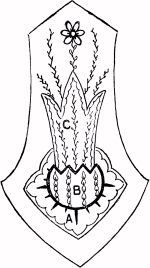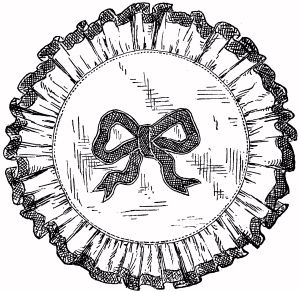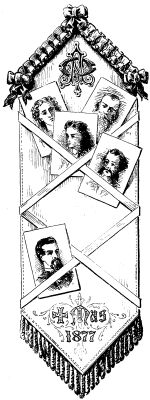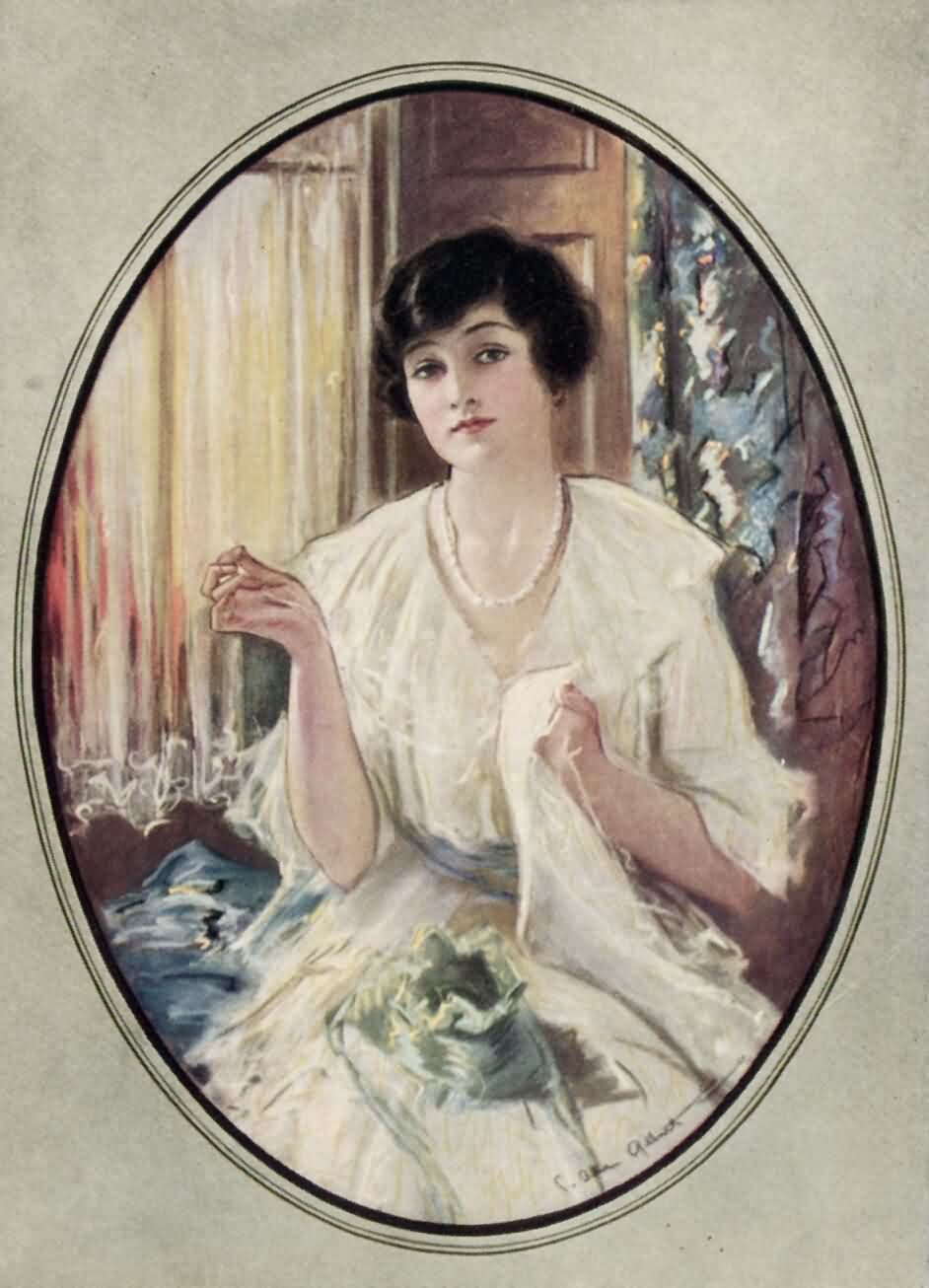|
All care
has been given to present these patterns in the original form.
KnitHeaven
is not responsible for errors.
A Frame of Autumn Leaves.
Procure an oblong bit of tin, eight inches by ten,
or ten inches by twelve, and have a large oval cut
out in the middle. Paint the tin with two coats of
black, glue a small group of leaves in each corner,
with a wire spray or tendril to connect them, varnish
with two coats of copal, and put a small picture behind
the oval.
A Frame of Maiden-Hair.
Cut a pasteboard frame three inches wide of the size
you need, and sew thickly all over it little sprays of
maiden-hair ferns, pressed and dried. It is fastened to
the wall with a pin at each corner, and of course
does not support a glass. The effect of the light fern
shapes against the wall is very delicate and graceful,
and unsubstantial as it may seem, the frame lasts a long
time, especially if, when the maiden-hair first begins to
curl, the whole is taken down and re-pressed for two or
three days under a heavy book.
Novelties in Fern-Work.
see here
We hope some of you have collected a good supply of
ferns of the different colors,—deep
brown, yellow, green and white,—for by
means of a new process you can make something
really beautiful with them. It requires deft fingers
and good eyes, but with practice and patience any
of you could manage it. Supposing it to be a
table-top which you wish to ornament, you proceed
as follows: Paint the wood all over with black or
very dark brown; let it dry, and rub it smooth
with pumice. Next varnish. And here comes the
point of the process. While the varnish is wet,
lay your ferns down upon it, following a design
which you have arranged clearly in your head, or
marked beforehand on a sheet of paper. A pin's
point will aid you to move and place the fragile
stems, which must not be much handled, and must
lie perfectly flat, with no little projecting points to
mar the effect, which when done should be like
mosaic-work. As soon as the pattern is in place,
varnish again immediately. The ferns, thus
inclosed in a double wall of varnish, will keep their
places perfectly. Next day, when all is dry, varnish
once more. Small articles of white holly-wood
decorated in this way are very pretty, and
a thin china plate with an overlaying of these varnished
ferns becomes a beautiful and ornamental card-receiver.
An old cane-seated chair will answer perfectly
to make this, provided the frame-work is
strong and good. Cut away the cane and insert in
its place a stout bag of twilled linen, the size of the
seat and about ten inches deep. Around this bag
sew eight pockets, each large enough for a pair of
shoes. The round pocket left in the middle will
serve to hold stockings. Have a bit of thin wood
cut to fit the seat of the chair; fasten on this a
cushion covered with cretonne, with a deep frill all
around (or a narrow frill, provided you prefer to
fasten the deep ruffle around the chair itself, as
shown in the picture), and a little loop in front by
which the seat can be raised like the lid of a box,
when the shoes are wanted. This chair is really a most
convenient piece of furniture for a bedroom.

PATTERN OF EACH OF THE FOUR SIDES OF SCRAP-BAG.

SCRAP-BAG IN TURKISH TOWELING.
Scrap-Bags in Turkish Toweling.
These are convenient little affairs.
Hung on the gas-fixture beside a looking-glass,
or on a hook above the work-table, they will be
found just the things to catch odds and ends, such as hair,
burnt matches, ravelings and shreds of cloth, which are always
accumulating, and for which many city bedrooms afford
no receptacle. The materials needed are three-quarters
of a yard of pale-brown Turkish toweling,
six yards of red worsted braid, four steel rings (to
hold the strings), one-eighth of a yard each of blue,
white, and scarlet cashmere, a skein each of blue,
red, green, yellow, and black worsted, and a small
red tassel in chenille or silk.
Cut four pieces of the toweling, twelve inches
long and six and a half wide, and shape them
according to diagram.
Bind each around with braid. Cut out a shape
in cashmere of the three colors laid one over the
other, and button-hole it on with worsted, contrasting
the shades in as gay and marked a manner as
possible. In the design given, A is white cashmere,
B red, and C blue. A is button-holed with green,
B with black, and C with yellow. B is chain-stitched
in blue and white lines, C feather-stitched
in white and yellow. The daisy-like flower above
is white, with a yellow center and a green stem,
and the long lines of stitching on either side are in
red and black. Some of these bags are very pretty.
This bag could be simplified by using no cashmere,
and feather-stitching each quarter diagonally across
with alternate black, red, and yellow lines.

ANOTHER SCRAP-BAG (SILVER PERFORATED PAPER AND CROCHET-WORK).
Another Scrap-Bag.
The upper part of this bag is made of silver perforated paper.
Buy a strip a foot long and six inches wide, and embroider
it all over in alternate lines of cross and single stitching,
using single zephyr worsted, blue or rose-colored.
Cut a piece of stiff card-board of exactly the same size,
and line it with pink or blue silk to match the worsted. Sew the
two ends together to form a circle, lay the silver
paper smoothly over it, stitch down, and trim both
edges with plaited satin ribbon three-quarters of
an inch wide.
This is the top of your bag. The bottom is
crocheted in worsted by the ordinary long stitch,
and sewed to the silver-paper top piece under the
satin ribbon. A worsted tassel finishes the lower end.
Artistic Embroidery.
Just here a word to the girls about embroidery.
In old days, when embroidery was the chief
occupation of noble dames and demoiselles, the
needle was used as a paint-brush might be, to
make a picture of some real thing or some ideal
occurrence. For instance: the Bayeux tapestry,
worked in the eleventh century by Matilda, wife
of William the Conqueror, and her ladies, is a
continuous series of pictures, two hundred and
fourteen feet long by about two feet wide, which
represent scenes in the invasion and conquest of
England. Old as it is, the colors are still undimmed
and brilliant. Even so lately as the last century,
ladies designed their own patterns, and embroidered
court dresses and trimmings with flowers
and birds copied from nature. But for many
years back fancy-work has degenerated into the
following of set models, without exercising any
"fancy" of one's own at all. Now the old method
is come into fashion again, and it means so
much more, and is so vastly more interesting
than copying a cut-and-dried pattern from a
shop, that we long to set you all to trying your
hands at it. For example, if you want a
cushion with a group of daisies, gather a handful
of fresh ones,—take a bit of linen or china crape, or
fine crash or pongee, and, with green and white and gray and
gold-colored silks, make a picture of the daisies
as they look to you, not using any particular kind
of stitch, but employing long ones or short ones,
or loose or tight ones, just as comes most easily in
giving the effect you want to get. This is much
nicer than counting the stitches on a paper pattern
and a bit of canvas, and when done, produces a
much better effect. Even in winter, a real flower
or a fern-spray, by way of model, can always be
found in the flower-shops or greenhouses. Practice
will stimulate invention and suggest all sorts
of devices and ideas. Bits of pretty stuffs will catch
your eye as adaptable for use, and oddly tinted
silks (the old, faded colors often work in better
than fresh ones), patterns on fans, on rice paper,
on Japanese pictures—all sorts of things—will serve
as material for your fancy. And when your work
is done it will be original, and, as such, more
valuable and interesting than any shop model, however
beautiful in itself, can possibly be.
Oriental Work.
Very gay and quaint effects are produced with
this work, which is an adaptation of the well-known
Eastern embroideries. Its ground-work is plain
cashmere or flannel, red, black or blue, on which
small fantastically shaped figures in variously colored
velvets or cashmeres are laid and button-holed
down with floss silks. All sorts of forms are
employed for these figures—stars, crescents, circles,
trefoils, shields, palm-leaves, griffins, imps; and
little wheels and comets in feather-stitch and cat-stitch
are inserted between, to add to the oddity of
the whole. These forms can be bought at a low
price in almost any fancy shop. A good deal
of ingenuity and taste can be shown in arranging
and blending the figures richly and brilliantly,
without making them too bright and glaring.
Table-covers in this work should have falls of
deep points, pinked on the edges. Smaller points
of white cashmere are sometimes inserted between
the deep ones, and similarly decorated. Bright
little tassels are swung between the points by
twisted silk cords. The tassels are made of strips
of scarlet and white flannel, cut almost across, in
narrow fringes, rolled into shape, and confined by
a tiny heading of flannel embroidered with silk.
Sofa-pillows in this Oriental work are bright and
effective, also wall-pockets and brackets—in fact, it
can be applied in many ways. The bracket shapes
must be cut in wood, and topped with flannel, the
embroidered piece hanging across the
front like a miniature drapery.
Bedside Rugs.
The prettiest bedside rug which we ever saw was made
in part of a snow-white lamb's-wool mat. This was laid
in the center of a stout burlap, which projected
six inches beyond the fleece all around, and was
bordered with a band of embroidery on canvas six
inches wide, the whole being lined with flannel and
finished with a cord and a heavy tassel at each corner.
A simpler rug is made of brown burlap, with
a pattern in cross-stitch, worked in double zephyr worsteds of gay colors. Initials, or a motto, can
be embroidered in the middle. The burlap can
be fringed out around the edges for a finish.
A Rag Rug.
An effective rug can be made in this way: Cut
long inch-wide strips of cloths, flannels, and various
kinds of material (widening the strip, however,
in proportion as the fabric is thinner). Sew the
ends together so as to make one very long strip,
which, for convenience' sake, can be loosely wound
up in a ball. Then, with a very large wooden
crochet-needle, you crochet a circle, a square, or
oblong mat of this rag-strip, just as with cotton or
worsted. It makes a strong, durable, and, with
bright and tasteful colors, a very pretty rug.
A Screen.
A folding clothes-horse with two leaves, such as
is used in laundries, makes the foundation for this
screen. The wood is painted solid black, and
covered inside and out with very yellow unbleached
cotton, stretched tightly over the frame, and held
down by black upholstery braid fastened on with
gilt nails. A design in flowers, leaves, birds,
double circles, crescents, and parallel bars, to imitate
the Japanese style of decoration, is painted in
oil colors on the cotton, and a motto on the wood
along the top. If the motto is arranged to read
backward, the foreign effect of the whole will be
enhanced. We have seen a striking screen of this
sort made by a little girl who, as she could not
paint in oil colors, decorated the surface with
figures of various kinds cut from Japanese picture-papers,
such as are now sold for from ten to twenty
cents in the Japanese goods shops. Her figures
were so well pasted and arranged, that the screen
was one of the prettiest things in the bedroom.
Screens covered with pictures cut from magazines
and illustrated newspapers are very much
liked by boys and girls, and by some of their elders.
A Couvre-Pied.
This is a large oblong in loosely knitted double
zephyr wools, and is made double, dark brown on
one side, for instance, and pale blue on the other.
The two are united with a border in open crochet
of the brown, laced through with light blue ribbon,
which is finished at each corner with a loosely tied
bow and ends. The couvre-pied, as the name
indicates, is meant to cover the feet of a person
who lies on a sofa, and is an excellent present to
make to an elderly or invalid friend.
Tile or China Painting.
Don't be frightened at the word, dears. China-painting
is high art sometimes, and intricate and
difficult work often, but it is quite possible to produce
pretty effects without knowing a great deal
about either china or painting. Neither are the
materials of necessity expensive. All that you need,
to begin with, are a few half tubes of china or mineral
paints, which cost about as much as oil colors,
four or five camel's-hair brushes, a palette-knife, a
small phial of oil-of-lavender, and another of oil-of-turpentine,
a plain glazed china cup or plate or tile
to work on, and either a china palette or another
plate on which to rub the paints. For colors,
black, capuchine red, rose-pink, yellow, blue, green and brown are an ample
assortment for a novice and for purposes of practice. We would advise only two
tubes, one of black and one of rose pink, which are colors that do not betray
your confidence when it comes to baking. For the chief difficulty in
china-painting is that to be permanent the work must be "fired,"—that is, fused
by a great heat in a furnace,—and it requires a great deal of experience to
learn what the different tints are likely to do under this test. Some
colors—yellow, for instance—eat up, so to speak, the colors laid over them.
Others change tint. Pinks and some of the greens grow more intense; white cannot
be trusted, and mixing one paint with another, as in oils, can only be done
safely by experts. It is well, therefore, to begin with two simple colors, and
you will be surprised to see how much may be done with them. A cup
of transparent white china, the handle painted
black, a Japanese-looking bough with black foliage
and pink blossoms thrown over it, and a little motto,
has a really charming effect. But be sure to put
on the pink very pale, and the black, not in a hard,
solid streak, but delicately, to suggest shading from
dark to light, or the result of the baking will be
disappointment.
The method of preparing the colors is to squeeze
a very little paint from each tube upon your palette
or plate; take a tiny drop of oil-of-lavender on the
palette-knife, and with it rub the paint smooth. It
should be thinned just enough to work smoothly;
every drop of oil added after that is a disadvantage.
Use a separate brush for each color, and wash them
thoroughly with soap and hot water before putting
them aside. The painting should be set away
where no dust can come to it, and it will dry rapidly
in forty-eight hours or less. Elaborate work often
requires repainting after baking, the process being
repeated several times; but for simpler designs
one baking is usually enough. There are bakeries
in Boston, New York, and others of our large cities,
to which china can be sent, the price of baking
being about ten cents for each article.
Other Modes of Decorating China.
The picture-books which are to be found at the
Japanese stores nowadays suggest numberless excellent
designs for china decorating. So do the
"Walter Crane Fairy-tales." A plain olive or
cream-colored tile with a pattern in bamboo-boughs
and little birds, a milk-jug in gray with leaves and
a motto in black, a set of tiny butter-plates with
initials and a flower-spray on each, are easy things
to attempt and very effective when done. Pie-dishes
can be ornamented with a long, sketchy
branch of blossoms or a flight of swallows across
the bottom, and we have seen those small dishes
of Nancy ware, in which eggs are first poached and
then served on table, made very pretty by a painting
on each of a chicken, done in soft browns and
reds, with a little line to frame it in and run down
along the handle. What we have mentioned
here are only suggestions; a little patience and
practice will soon help you to other patterns of
your own, and we can't help hoping that some of you will
be tempted to try your hands at this delightful art.
Drawing and Painting on Wood.
Articles in plain white wood can be bought almost anywhere
nowadays. Pen-trays, letter-racks, easels, paper-knives,
photograph-frames, watch-cases, needle-books,
portfolios, glove-boxes, fans, silk-winders—there is no end
to the variety which can be had, and had at a very moderate
price. Now, any girl or boy among you with a
paint-box and a little taste for drawing, can make a really
pretty gift by decorating some one of these wooden things,
either in color or with pen drawings in brown or black.
The pattern need by no means be elaborate. A
wreath of ivy simply out-lined in sepia or india-ink, or a group of figures
sketched with the same, produces a very pleasing and harmonious effect.
Here is a suggestion for such of you as live by
the sea, and who know something about drawing.
Search for clam-shells on the beach, and select the
whitest and most perfectly formed. Separate the
two shells, cleanse them thoroughly, and make on
the smooth pearly lining of each a little drawing in
sepia. It will serve as a receiver to stand on a
lady's toilet and hold rings and trinkets, or it can be used as an ash-holder by a smoking gentleman,
or to contain pens on a writing-table.
Another shoe-chair as nice as that pictured
above can be made out of a barrel by any girl
who has a father or big brother to help her a little
with the carpentering. The barrel is cut as in
Fig. 1, so as to form a back and a low front.
The back is stuffed a little, and covered with chintz
nearly down to the floor. The front has a deep
frill tacked on all around the chair. Four blocks
are nailed inside the barrel to support a round of
wood, stuffed and cushioned with the same chintz,
to serve as a seat.
A straight shoe-bag, with eight pockets, is made
in the same chintz, and tacked firmly all around
the inside. A loop of the chintz serves to raise the
seat. Four castors screwed to the bottom of the
barrel will be an improvement, as the chair without
them cannot easily be moved about. About five
yards of chintz will be required for the covering; or
you might use the merino of an old dress.
See
here1. SHOWS MANNER OF CUTTING BARREL.
2. BARREL SHOE-CHAIR COMPLETED.
3. INTERIOR OF BARREL SHOE-CHAIR.
4. DIAGRAM SHOWING MODE OF MAKING POCKETS FOR BARREL SHOE-CHAIR.
A Muslin Tidy.

A MUSLIN TIDY TRIMMED WITH LACE FOOTING.
Three-quarters of a yard of clear French muslin
will be needed for this. Lay a large dinner-plate
down on the muslin, draw the circle made by its
edge with a pencil, cut out, and lightly whip it
round, pulling the thread a little to keep the circle
perfect. Measure the circle, and cut a straight
muslin ruffle, five inches wide and a little less than
twice as long as the measure. Roll one edge finely,
and overhand on a plain lace footing an inch and a
half wide. Whip the other edge, and sew it round
the circle, graduating the fullness equally.
Baste a bit of lace footing three-quarters of an
inch wide in the middle of the circle, giving it the
form of a bow-knot with two ends. The lace must be bent and folded
into the form, but not cut. Run the edges with embroidery cotton,
and button-hole all round. Then, with sharp scissors, cut away the
muslin underneath, leaving the bow-knot transparent on a thicker
ground. Dry-flute the ruffle. This little affair is very dainty and odd,
one of the prettiest things which we have seen lately.
An Illuminated Border for a Photograph.
This is to illuminate
a border or "mount" around a favorite photograph. The picture
must first be pasted on a large sheet of tinted card-board, pale
cream or gray being the best tints to select. You then measure the spaces
for your frame, which should be square if the picture is oval or round,
and outline them lightly in lead-pencil. Next you
sketch and paint your pattern,—flowers, leaves,
birds, butterflies, or a set pattern, as you prefer,—putting
the designs thickly together; and, lastly,
you fill all the blank spaces in with gold paint,
leaving the pattern in colors on a gilded ground.
The outer edge of the frame should be broken into
little scallops or trefoils in gold, and the card-board
should be large enough to leave a space of at least
three inches between the illuminated border and
the frame, which should be a wide band of dull
gilding or pale-colored wood, with a tiny line of
black to relieve it. The ornament should, if possible,
chord in some way with the picture, Thus a
photograph of a Madonna might have the annunciation-lilies
and passion-flowers on the gold ground.
A Book of Texts.
Another choice thing which can be done by a
skillful illuminator is a small book, containing a
few favorite texts, chosen by some friend. Half-a-dozen
will be enough. Each text occupies a separate
page, and is carefully lettered in red or black,
with decorated initials, and a border in colors. A
great deal of taste can be shown in the arrangement
of these borders, which should be appropriate
to the text they surround. A title-page is added,
and the book is bound in some quaint way. A
cover of parchment or white vellum, illuminated
also, can be made very beautiful.

CARTE-DE-VISITE RECEIVER.
A Carte-de-Visite Receiver.
For this you must procure from the tin-man a
strip of tin three times as long as it is wide—say
six inches by eighteen—with each end shaped to a
point, as indicated in the picture. Measure off
two bits of card-board of exactly the same size and
shape; cover one with silk or muslin for a back,
and the other with Java canvas, cloth, or velvet,
embroidered with a monogram in the upper point,
and a little pattern or motto in the lower. Lay
the double coverings one on each side of the tin,
and cross the outside one with narrow ribbons,
arranged as in the picture. Overhand firmly all
around; finish the top with a plaited ribbon and a
little bow and loop to hang it by, and the bottom
with a bullion fringe of the color of the ribbon.
A Pair of Bellows.
There seems no end to the pretty devices which
proficients in painting can accomplish. We saw not
long since a pair of wooden bellows which had
been decorated with a painting of a tiny owl sitting
on a bough, and the motto "Blow, blow, thou
bitter wind." Why should not some of you try
your hands at something similar? Wood fires,
thank heaven, are much more common than they
used to be, and most of you must know a cozy
chimney corner where a pretty pair of bellows
would be valued.
A Door-Panel.
A great bunch of field-flowers, or fruit-boughs,
or Virginia-creeper, painted in water-paints on the
panel of an ordinary door, is another nice thing for
you young artists to attempt. Perhaps you will object
that a picture on a door can hardly be called
a Christmas present; but we don't know.
Anything which loving fingers can make,
and loving hearts enjoy, is a gift worthy
of Christmas or any other time.
A Sachet in Water-Colors.
Another dainty idea for you who can paint is a small
perfume-case of white or pale-colored silk or satin,
on which is painted a bunch of flowers or a little motto.
The flowers must be small ones, such as forget-me-nots
or purple and white violets. A great deal of white
paint—body color, as it is called—should
be mixed with the color, to make it thick enough not
to soak and stain the silk along the
edges of the pattern. Some people paint the whole
design in solid white, let it dry, and then put on
the color over the white. Others mix a little ox-gall
with the paint.
Decorated Candles.
The large wax or composition candles, of a firm
texture, are best for purposes of decoration. Water-color
paints can be used, or those powders which come for coloring wax flowers. In either case it
will be necessary to use a little ox-gall to give the
paint consistency. A band of solid tint—crimson,
black, blue or gold—is usually put around the
middle of the candle, with a pattern in flowers or
small bright points above and below. Spirals of
blue forget-me-nots all over the candle are pretty,
or sprays of leaves and berries set in a regular
pattern. These gay candles are considered ornamental
for a writing-table, and look well in the
brass candlesticks which are so much used just
now, though we confess to a preference for unornamented
candles of one solid tint.
A Rustic Jardinière.
Boys and girls who live in the country hardly
know how lucky they are, or what mines of materials
for clever handiwork lie close by them in the
fruitful, generous woods. What with cones and
leaves and moss and lichens and bark and fungi
and twigs and ferns, these great green store-houses
beat all the fancy shops for variety and beauty, and
their "stock" is given away without money or
price to all who choose to take. Most of you know
something of the infinite variety of things which
can be made out of these wood treasures, though
nobody knows, or can know, all. Now, we want to
tell you of a new thing, not at all difficult to make,
and which would be a lovely surprise for some one
this coming Christmas.
It is a rustic jardinière, or flower-pot. The first
step toward making it is to find a small stump
about ten inches high, and as odd and twisted in
shape as possible. It should have a base broader
than its top, and three or four little branches projecting
from its sides. Carry this treasure home,
brush off any dirt which may cling to it, and ornament
it with mosses and lichens, glued on to look
as natural as possible. Make three small cornucopias
of pasteboard; cover them also with mosses
and lichens, and fasten them to the stump between
the forks of the branches, using small brads or
tacks to keep them firm. Stuff the cornucopias
with dry moss, and arrange in each a bouquet of
grasses, autumn leaves, and dried ferns, dipping
the end of each stem in flour paste, to make it
secure in its place. Sprays of blackberry-vine or
michella, and the satin-white pods of the old-fashioned
"honesty," make an effective addition.
When done, we have a delightful winter-garden,
which will keep its beauty through the months of
snow and sleet, and brighten any room it stands in.
Nor is its use over when winter ends, for, inserting
small glass phials in the cornucopias, fresh flowers
can be kept in them as in a vase, and the grays
and browns of the lichened wood set off their hues
far better than any gay vase could.
Another Jardinière.
Another rustic flower-holder can be made by
selecting three knotty twigs, two and a half feet
long and about an inch in diameter, and nailing
them together in the form of a tripod, one half
serving as a base, the other to hold a small flower-pot
or a goblet whose foot has been broken off.
The lower half should be strengthened with cross
pieces nailed on, and both halves with twists of
wild grape-vine or green briar, wired at their crossings
to hold them firmly in place. When the frame
is ready, melt together half a pound of bees'-wax,
a quarter of a pound of rosin, and enough powdered
burnt-umber to give a dark brown color;
and pour the mixture on boiling hot. It will give
the wood a rich tint. Fill the pot with sand, place
over the sand a layer of green moss well pulled
apart, and in that arrange a bouquet of dried
leaves, ferns and grasses, or, if it is summer-time,
wild flowers and vines.
Please
do not post these patterns to another website. However, Please feel free
to post a link to this page:
http://www.knitheaven.com/vintagepatterns/morecrafts3.htm |











